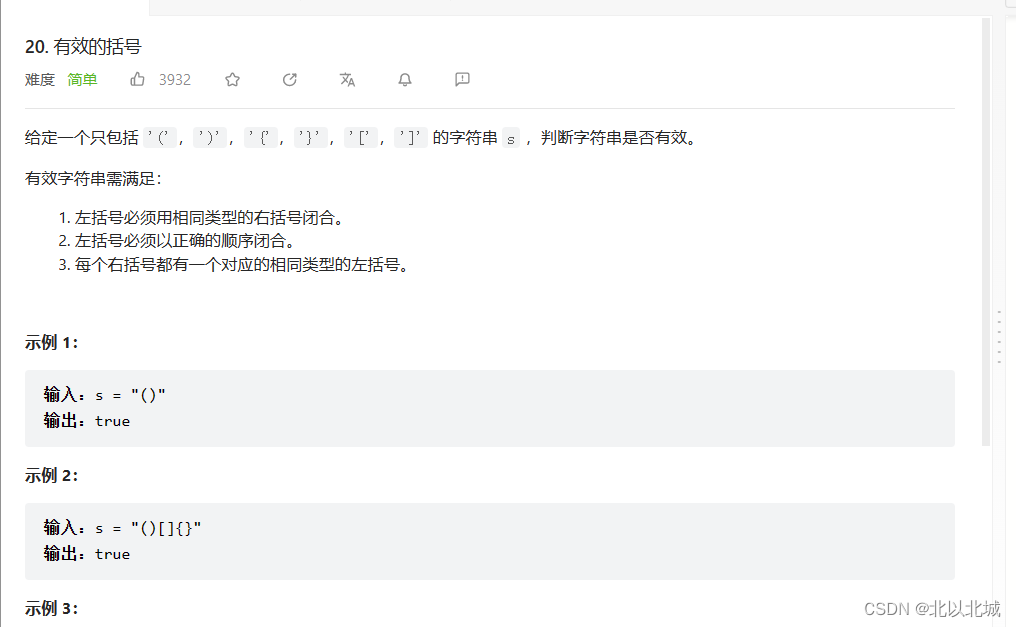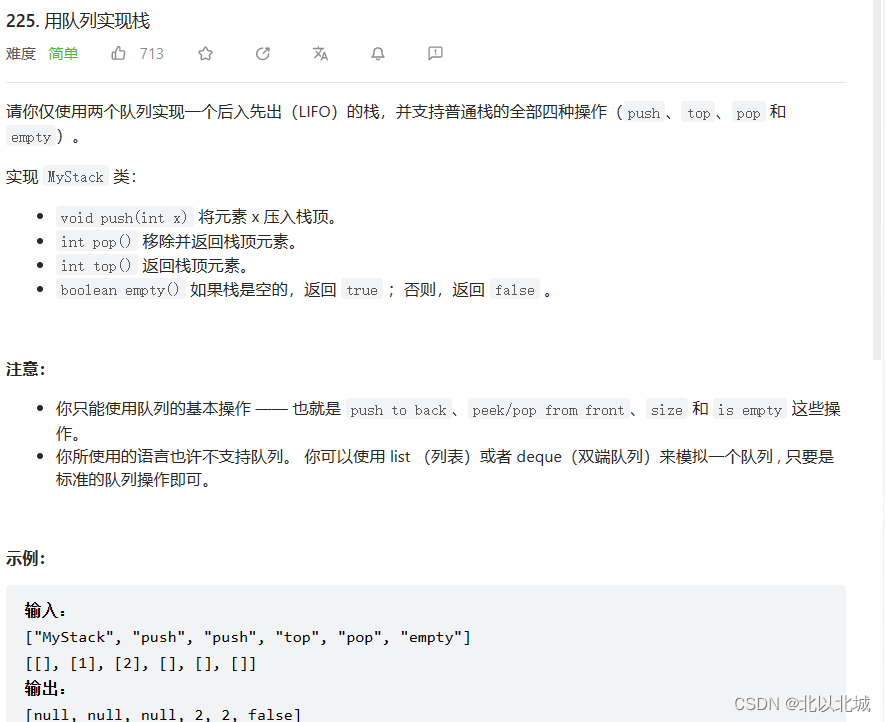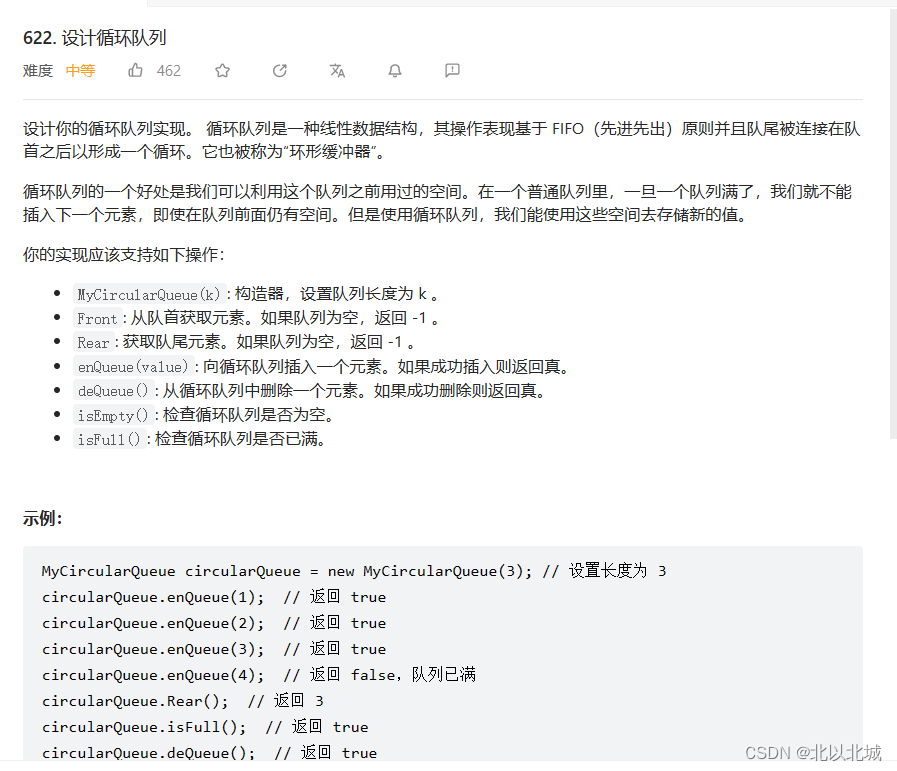有效的括号

主要是栈的实现,理解了就简单了,这次需要注意的是开辟空间用int,一开始用char时一直运行不出来
typedef int STDataType;
typedef struct Stack
{
STDataType* a;
STDataType top;
STDataType capacity;
}ST;
void StackInit(ST* pst)
{
assert(pst);
pst->a=NULL;
pst->top=0;
pst->capacity=0;
}
void StackPush(ST* pst,STDataType x)
{
assert(pst);
if(pst->top==pst->capacity)
{
STDataType newcapacity=pst->capacity==0?4:pst->capacity*2;
STDataType* newnode=(STDataType*)realloc(pst->a,sizeof(STDataType)*newcapacity);
if(newnode==NULL)
{
printf("realloc fail");
return;
}
pst->a=newnode;
pst->capacity=newcapacity;
}
pst->a[pst->top]=x;
pst->top++;
}
bool StackEmpty(ST* pst)
{
assert(pst);
return pst->top==0;
}
void StackPop(ST* pst)
{
assert(pst);
assert(!StackEmpty(pst));
pst->top--;
}
void StackDestory(ST* pst)
{
assert(pst);
free(pst->a);
pst->a=NULL;
pst->top=pst->capacity=0;
}
STDataType StackTop(ST* pst)
{
assert(pst);
assert(!StackEmpty(pst));
return pst->a[pst->top-1];
}
bool isValid(char * s){
ST st;
StackInit(&st);
while(*s)
{
if(*s=='('
||*s=='{'
||*s=='[')
{
StackPush(&st,*s);
}
else
{
if(StackEmpty(&st))
{
StackDestory(&st);
return false;
}
STDataType top=StackTop(&st);
StackPop(&st);
if((*s==')'&&top!='(')||(*s==']'&&top!='[')||(*s=='}'&&top!='{'))
{
StackDestory(&st);
return false;
}
}
s++;
}
bool ret=StackEmpty(&st);
StackDestory(&st);
return ret;
}
用队列实现栈

用两个队列进行实现,非空队列的元素依次移到空队列,只剩最后一个元素时,打印该元素
typedef int QDataType;
typedef struct QListNode
{
QDataType* next;
QDataType data;
}QLNode;
typedef struct Queue
{
QLNode* phead;
QLNode* ptail;
int size;
}Queue;
void QueueInit(Queue* pq)
{
assert(pq);
pq->phead=pq->ptail=NULL;
pq->size=0;
}
void QueueDestory(Queue* pq)
{
assert(pq);
QLNode* cur=pq->phead;
while(cur)
{
QLNode* next=cur->next;
free(cur);
cur=next;
}
pq->phead=pq->ptail=NULL;
pq->size=0;
}
bool QueueEmpty(Queue* pq)
{
assert(pq);
return pq->size==0;
}
void QueuePush(Queue* pq,QDataType x)
{
assert(pq);
QLNode* newnode=(QLNode*)malloc(sizeof(QLNode));
if(newnode==NULL)
{
printf("malloc fail");
return;
}
newnode->next=NULL;
newnode->data=x;
if(pq->ptail==NULL)
{
assert(pq->phead==NULL);
pq->phead=pq->ptail=newnode;
}
else
{
pq->ptail->next=newnode;
pq->ptail=newnode;
}
pq->size++;
}
void QueuePop(Queue* pq)
{
assert(pq);
assert(!QueueEmpty(pq));
if(pq->phead->next==NULL)
{
free(pq->phead);
pq->phead=pq->ptail=NULL;
}
else
{
QLNode* next=pq->phead->next;
free(pq->phead);
pq->phead=next;
}
pq->size--;
}
QDataType QueueFront(Queue* pq)
{
assert(pq);
assert(!QueueEmpty(pq));
return pq->phead->data;
}
QDataType QueueBack(Queue* pq)
{
assert(pq);
assert(!QueueEmpty(pq));
return pq->ptail->data;
}
int QueueSize(Queue* pq)
{
assert(pq);
return pq->size;
}
typedef struct {
Queue q1;
Queue q2;
} MyStack;
MyStack* myStackCreate() {
MyStack* obj=(MyStack*)malloc(sizeof(MyStack));
if(obj==NULL)
{
printf("malloc fail");
return NULL;
}
QueueInit(&obj->q1);
QueueInit(&obj->q2);
return obj;
}
void myStackPush(MyStack* obj, int x) {
if(!QueueEmpty(&obj->q1))
{
QueuePush(&obj->q1,x);
}
else
{
QueuePush(&obj->q2,x);
}
}
int myStackPop(MyStack* obj) {
Queue* pqempty=&obj->q1;
Queue* pqnonempty=&obj->q2;
if(!QueueEmpty(&obj->q1))
{
pqempty=&obj->q2;
pqnonempty=&obj->q1;
}
while(QueueSize(pqnonempty)>1)
{
QueuePush(pqempty,QueueFront(pqnonempty));
QueuePop(pqnonempty);
}
int top=QueueFront(pqnonempty);
QueuePop(pqnonempty);
return top;
}
int myStackTop(MyStack* obj) {
if(!QueueEmpty(&obj->q1))
{
return QueueBack(&obj->q1);
}
else
{
return QueueBack(&obj->q2);
}
}
bool myStackEmpty(MyStack* obj) {
return QueueEmpty(&obj->q1)&&QueueEmpty(&obj->q2);
}
void myStackFree(MyStack* obj) {
QueueDestory(&obj->q1);
QueueDestory(&obj->q2);
free(obj);
}
用栈实现队列
用两个栈实现,一个为pushst,一个为popst,将pushst数据依次放入popst中,依次输出,即为队列输出顺序
typedef int STDataType;
typedef struct Stack
{
STDataType* a;
STDataType top;
STDataType capacity;
}Stack;
void StackInit(Stack* pt)
{
assert(pt);
pt->a=NULL;
pt->top=pt->capacity=0;
}
void StackDestory(Stack* pt)
{
assert(pt);
free(pt->a);
pt->a=NULL;
pt->top=pt->capacity=0;
}
void StackPush(Stack* pt,STDataType x)
{
assert(pt);
if(pt->top==pt->capacity)
{
STDataType newcapacity=pt->capacity==0?4:pt->capacity*2;
STDataType* ret=(STDataType*)realloc(pt->a,sizeof(STDataType)*newcapacity);
if(ret==NULL)
{
printf("realloc fail");
return;
}
pt->capacity=newcapacity;
pt->a=ret;
}
pt->a[pt->top]=x;
pt->top++;
}
bool StackEmpty(Stack* pt)
{
assert(pt);
return pt->top==0;
}
void StackPop(Stack* pt)
{
assert(pt);
assert(!StackEmpty(pt));
pt->top--;
}
STDataType StackTop(Stack* pt)
{
assert(pt);
assert(!StackEmpty(pt));
return pt->a[pt->top-1];
}
int StackSize(Stack* pt)
{
assert(pt);
return pt->top;
}
typedef struct {
Stack pushst;
Stack popst;
} MyQueue;
MyQueue* myQueueCreate() {
MyQueue* obj=(MyQueue*)malloc(sizeof(MyQueue));
if(obj==NULL)
{
printf("malloc fail");
return NULL;
}
StackInit(&obj->pushst);
StackInit(&obj->popst);
return obj;
}
void myQueuePush(MyQueue* obj, int x) {
StackPush(&obj->pushst,x);
}
int myQueuePop(MyQueue* obj) {
int temp=myQueuePeek(obj);
StackPop(&obj->popst);
return temp;
}
int myQueuePeek(MyQueue* obj) {
if(StackEmpty(&obj->popst))
{
while(!StackEmpty(&obj->pushst))
{
StackPush(&obj->popst,StackTop(&obj->pushst));
StackPop(&obj->pushst);
}
}
return StackTop(&obj->popst);
}
bool myQueueEmpty(MyQueue* obj) {
return StackEmpty(&obj->pushst)&&StackEmpty(&obj->popst);
}
void myQueueFree(MyQueue* obj) {
StackDestory(&obj->pushst);
StackDestory(&obj->popst);
free(obj);
}
设计循环队列

用数组实现队列,理解列表为空时:rear == front,满时:rear+1== front
当求队尾元素时,坐标为(rear-1+k+1)%(k+1)
typedef int QDataType;
typedef struct QNode
{
struct QNode* next;
QDataType data;
}QNode;
typedef struct Queue
{
QNode* phead;
QNode* ptail;
int size;
}Queue;
void QueueInit(Queue* pq)
{
assert(pq);
pq->phead=NULL;
pq->ptail=NULL;
pq->size=0;
}
void QueueDestory(Queue* pq)
{
assert(pq);
QNode* cur=pq->phead;
while(cur)
{
QNode* next=cur->next;
free(cur);
cur=next;
}
pq->phead=pq->ptail=NULL;
pq->size=0;
}
bool QueueEmpty(Queue* pq)
{
assert(pq);
return pq->size==0;
}
void QueuePush(Queue* pq,QDataType x)
{
assert(pq);
QNode* newnode=(QNode*)malloc(sizeof(QNode));
if(newnode==NULL)
{
printf("malloc fail");
return;
}
newnode->next=NULL;
newnode->data=x;
if(pq->ptail==NULL)
{
assert(pq->phead==NULL);
pq->ptail=pq->phead=newnode;
}
else
{
pq->ptail->next=newnode;
pq->ptail=newnode;
}
pq->size++;
}
void QueuePop(Queue* pq)
{
assert(pq);
assert(!QueueEmpty(pq));
if(pq->phead->next==NULL)
{
free(pq->phead);
pq->phead=pq->ptail=NULL;
}
else
{
QNode* next=pq->phead->next;
free(pq->phead);
pq->phead=next;
}
pq->size--;
}
QDataType QueueFront(Queue* pq)
{
assert(pq);
assert(!QueueEmpty(pq));
return pq->phead->data;
}
QDataType QueueBack(Queue* pq)
{
assert(pq);
assert(!QueueEmpty(pq));
return pq->ptail->data;
}
int QueueSize(Queue* pq)
{
assert(pq);
assert(!QueueEmpty(pq));
return pq->size;
}
typedef struct {
int front;
int rear;
int k;
int* a;
} MyCircularQueue;
MyCircularQueue* myCircularQueueCreate(int k) {
MyCircularQueue* obj=(MyCircularQueue*)malloc(sizeof(MyCircularQueue));
if(obj==NULL)
{
printf("malloc fail\n");
return NULL;
}
obj->front=obj->rear=0;
obj->k=k;
obj->a=(int*)malloc(sizeof(int)*(k+1));
return obj;
}
bool myCircularQueueIsEmpty(MyCircularQueue* obj) {
return obj->front==obj->rear;
}
bool myCircularQueueIsFull(MyCircularQueue* obj) {
return (obj->rear+1)%(obj->k+1)==obj->front;
}
bool myCircularQueueEnQueue(MyCircularQueue* obj, int value) {
if(myCircularQueueIsFull(obj))
{
return false;
}
obj->a[obj->rear]=value;
obj->rear++;
obj->rear%=(obj->k+1);
return true;
}
bool myCircularQueueDeQueue(MyCircularQueue* obj) {
if(myCircularQueueIsEmpty(obj))
{
return false;
}
obj->front++;
obj->front%=(obj->k+1);
return true;
}
int myCircularQueueFront(MyCircularQueue* obj) {
if(myCircularQueueIsEmpty(obj))
{
return -1;
}
return obj->a[obj->front];
}
int myCircularQueueRear(MyCircularQueue* obj) {
if(myCircularQueueIsEmpty(obj))
{
return -1;
}
return obj->a[(obj->rear+obj->k)%(obj->k+1)];
}
void myCircularQueueFree(MyCircularQueue* obj) {
free(obj->a);
free(obj);
}





















 32
32











 被折叠的 条评论
为什么被折叠?
被折叠的 条评论
为什么被折叠?








